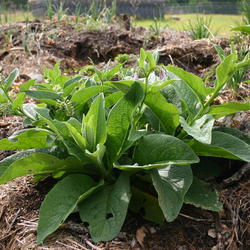Comfrey is incredible. It's a soil builder, a fertilizer, a compost enhancer, has medicinal properties, is a good feed source for animals, and much more. Let's talk about this chief of plants.
Only a few plants make my “absolute must grow” list, and in this series of articles I've been featuring them one by one. In past articles I've discussed chickweed, lambsquarters, sunroots (also known as Jerusalem Artichokes), tomatoes and yarrow. Hopefully you've been enjoying the series. Today we take a look at one of the cornerstones of permaculture plants: Comfrey.
Comfrey is a perennial herbaceous forb that is semi-evergreen in the south. It's a fairly finicky plant and sometimes you have to try a few times in a few different places before you finally get it established. Once you have it, though, it'll continue to persist, growing bigger and healthier each year.
It loves rich, moist soil and hates the hot direct sunshine that comes from the west. Planted in an east location with west-facing protection, it can thrive in Texas. If you've failed at comfrey in the past, it was probably due to excessively hot sunshine. Also, as I mentioned, it likes moist soil, but it hates to sit in water logged soil. So it's important to put it in a place that has good drainage.
So why grow it? The advantages of this plant are so numerous, it's hard to even know where to begin. For starters, it is perhaps the most famous of all dynamic nutrient accumulators, and is the chief of “soil building” perennials. An informal study published by the Permaculture Research Institute in Australia showed a 232% increase in organic matter in soils that had been planted with comfrey, as measured against nearby soil that was treated similar but did not have comfrey growing. Many books have been written, arguments argued, questions asked and research done, over the soil building aspects of comfrey. I am satisfied with the knowledge that comfrey is a soil builder, and that's good enough for me.
I plant comfrey along the edges of my gardens, and under my fruit trees. They don't compete much with the surrounding plants, and they grow quite quickly. A few times during the season I will cut them nearly completely to the ground, and toss the cuttings as a living mulch in the gardens and orchards. The nutrients in the leaves fertilize the other plants and the organic matter provides nice protection to the soil to hold moisture and protect against the sun.
The leaves are also used in compost production. Have a “dead” pile of compost? Mix in some green comfrey leaves to kick it right back into production! I've heard of a technique where people will fill a bucket with comfrey leaves, then fill it with water, and you have a liquid comfrey tea that you can use as a water fertilizer for your plants.
Another area where comfrey really shines is in the production of animal feed. Amazingly, comfrey has about 7 times as much protein, and 8 times the carbs, as soybeans! Some comfrey tests have shown up to 33% protein. Growing comfrey near your chicken pens is an excellent way to supplement your poultry feed. Throw them a few leaves each day and watch your feed bill go down. Nearly all mammal livestock produce well on comfrey, but they hesitate to eat it because it has little hairs on the leaves. If you crush the leaves a bit before presenting it to the animal, they're much more likely to eat it.
Comfrey also has numerous medicinal benefits, and is the subject of much controversy. It has certain substances (allantoin, rosmarinic acid, and various tannins) that promote skin regrowth and bone healing. In fact, one nickname of comfrey is “knit bone.” People in ages past have used comfrey to treat wounds, bone breaks and sprains, skin inflammations and more. The controversy arises because comfrey also contains a poisonous alkaloid called pyrrolizidine. This alkaloid can build up in the body and can cause liver damage and in extreme cases, death. This risk has led most countries (including the US) to ban the sale of comfrey products that are intended for oral consumption. So if you're interested in the powerful healing effects of comfrey, you must first be prepared to spend a long time researching before you do anything medicinally with this herb.
The plant Comfrey consists of the plants in the Symphytum genus. The one you may have seen is
Comfrey (Symphytum officinale) , which is the usual garden variety comfrey. It sets seed and can easily become invasive in certain conditions, taking over entire hillsides. I don't grow that species, nor do I recommend it to you. Instead, I recommend cultivars from the Bocking series, which are sterile varieties of the Symphytum x uplandicum species. These have all the benefits, vigor and advantages of the other Comfreys, but they don't set seed and therefore they stay exactly where you put them.
Russian Comfrey (Symphytum x uplandicum 'Bocking 14') is my favorite variety to grow, and it does very well for us in East Texas.
To get started growing comfrey, simply obtain some roots from another gardener or order them online. Plant these roots straight into the ground and the plant should emerge within a week or so. It's actually very easy to grow them in the ground, but they hate being potted in a container. For this reason, you almost never see comfrey in garden centers. So just get your roots, plant them straight down under the surface of the soil with the bud right up at ground level, and you'll be successful.
